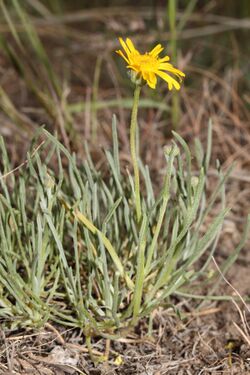Biology:Erigeron linearis
| Erigeron linearis | |
|---|---|

| |
| Erigeron linearis in Wenas Wildlife Area in Washington (state) | |
| Scientific classification | |
| Kingdom: | Plantae |
| Clade: | Tracheophytes |
| Clade: | Angiosperms |
| Clade: | Eudicots |
| Clade: | Asterids |
| Order: | Asterales |
| Family: | Asteraceae |
| Genus: | Erigeron |
| Species: | E. linearis
|
| Binomial name | |
| Erigeron linearis (Hook.) Piper
| |
| Synonyms[1] | |
| |
Erigeron linearis is a species of flowering plant in the family Asteraceae known by the common name desert yellow fleabane or narrow leaved fleabane. It is native to western North America.[2]
Description
Erigeron linearis is a small clumping perennial herb reaching a maximum height of 20 centimeters (8 inches), with a woody taproot. Its leaves are long and narrow, mostly clustered around the base of the stem, and are 2 to 9 cm (3⁄4 to 3 1⁄2 in) long, pale green to green, and lightly covered with short white hairs. The erect lightly hairy flower stems are leafless or have a few reduced linear leaves and usually produce only one flower head (though occasionally 2 or 3) each about 1 cm (3⁄8 in) wide. The flower has a center of many golden yellow disc florets and a fringe of as many as 38 pale to bright yellow or cream-colored ray florets. The fruit is an achene attached to a fluffy pappus with 10 to 20 bristles.[3] Seeds are presumably wind dispersed.
Distribution and Habitat
Erigeron linearis is native to the mountains of western North America from British Columbia as far south as Wyoming, northern Nevada and Mono County in California .[2][4] The species grows in open rocky slopes associated with the shrubs sagebrush, bitterbrush or juniper.[5]
Uses
Some Plateau Indian tribes used desert yellow fleabane as a poultice for treating sores.[6]
Gallery
References
- ↑ The Plant List, Erigeron linearis (Hook.) Piper
- ↑ 2.0 2.1 Calflora taxon report, University of California, Erigeron linearis (Hook.) Piper, Narrow leaved fleabane, desert yellow fleabane
- ↑ Jepson Manual Treatment
- ↑ Biota of North America Program 2014 county distribution map
- ↑ Flora of North America, Erigeron linearis (Hooker) Piper, 1906. Desert yellow fleabane
- ↑ Hunn, Eugene S. (1990). Nch'i-Wana, "The Big River": Mid-Columbia Indians and Their Land. University of Washington Press. p. 353. ISBN 0-295-97119-3.
External links
- United States Department of Agriculture Plants Profile
- Calphotos Photo gallery, University of California
Wikidata ☰ Q5388410 entry
 |




